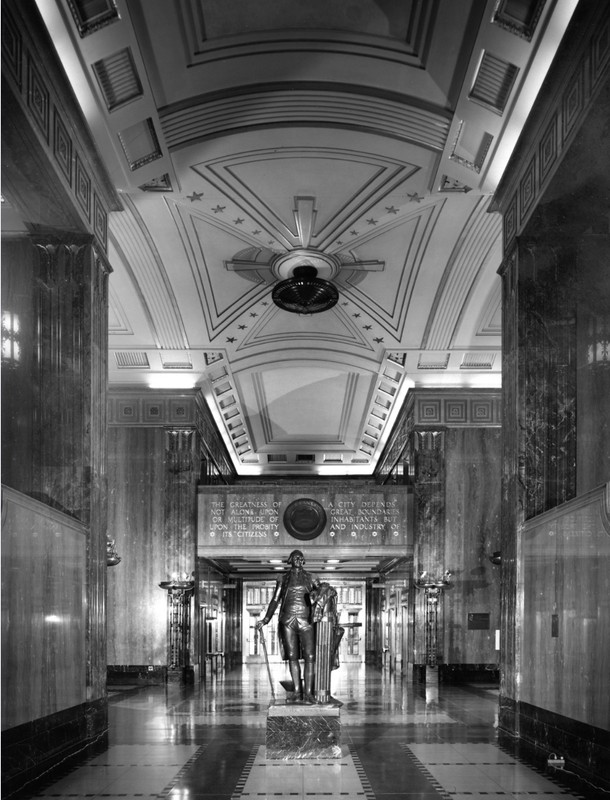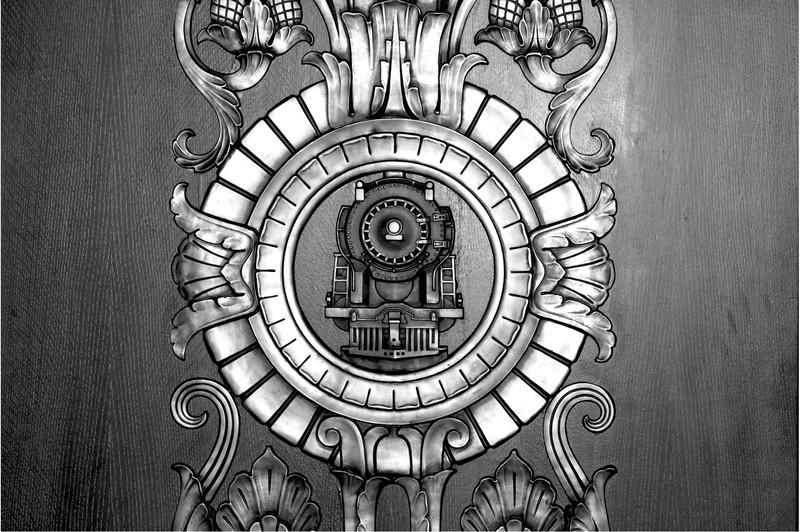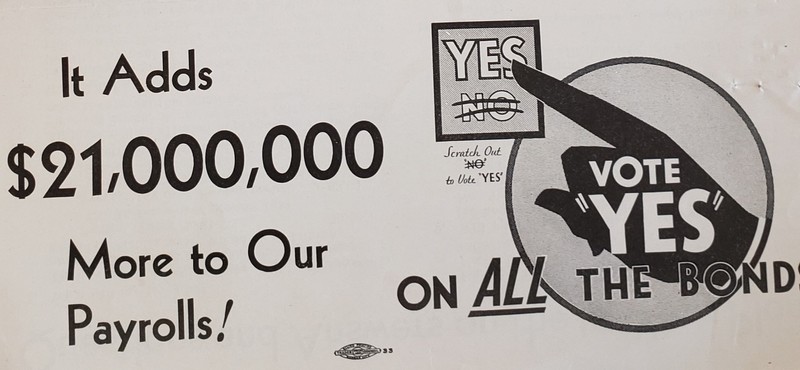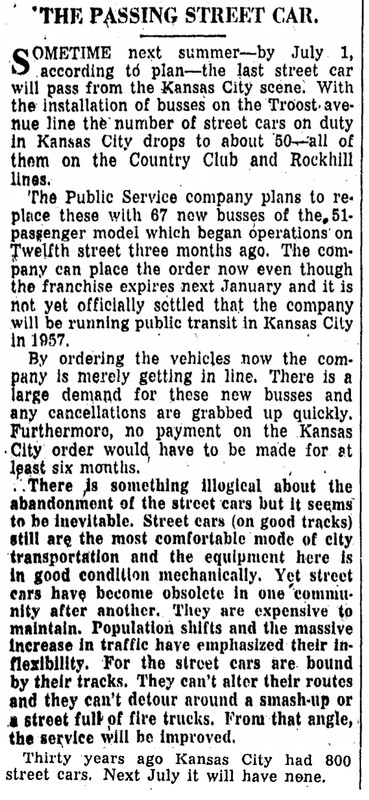1st Floor – Lobby/Rotunda
Introduction
Text-to-speech Audio
The Lobby is the grand entrance to City Hall that treats visitors to an impressive display of multi-colored marble and features numerous bronze adornments. While the majority of the building was designed for utility - with large windows for natural light and ventilation and office space described by promotional literature as, “plain, businesslike and unpretentious,” - the lobby and rotunda area on the first and second floor are a notable exception (Your City Hall, 1937). At the time of completion, this floor featured offices for the Water Department and City Treasurer, as these are City functions the public was expected to interact with most often. Therefore, City leaders such as City Manager H. F. McElroy worked closely with architecture firm Wight and Wight to design a lobby that is both functional and beautiful, possessing an aesthetic of grandeur.
Images
Interior of Main Lobby and Rotunda - Facing South

Detail of Bronze Metalwork - Train

Promotional Image for the 10-Year Bond Program

The Passing Street Car, The Kansas City Star, October 29, 1956

Backstory and Context
Text-to-speech Audio
City Hall was constructed as part of a joint bond program that included over $30 million worth of public works projects in the City of Kansas City, Missouri and Jackson County, Missouri. This bond program helped relieve the economic pressures of the Great Depression. The rotunda area features an engraved quote from Councilman A. N. Gossett (1861-1943) that reads: “The greatness of a city depends not alone upon great boundaries or a multitude of inhabitants but upon the probity and industry of its citizens.”
Notably, Kansas City’s first City Manager H. F. McElroy – a political insider with close ties to the Pendergast Democratic Machine – subscribed to the belief that people would rather be given jobs than charity. This outlook, combined with the potential for federal funding through New Deal Era programs such as the Public Works Administration (PWA) and later the Works Progress Administration (WPA), led to City leaders creating many part-time jobs and investing heavily in local industry (McFerrin).
It is estimated that 15,000 artists were out of work nationwide due to the economic impact of the Great Depression. Locally, the Pendergast political machine exercised tremendous influence in how WPA jobs were distributed. These two facts played a major role in the adornment of City Hall (Bean; City Hall, 12th Street | KC History). Additionally, promotional literature for the Ten Year Plan bond program heavily emphasized that $21 million would be added to local payrolls (Questions and Answers on the 10-Year Plan).
The building contains over 11,000 cubic feet of marble with over 10,000 cubic feet sourced domestically. The North and South entrances feature Pyrenees marble from South West France and St. Genevieve Istrian from St. Genevieve, MO. The flooring of the South Vestibule is Travertine from Tivoli, Italy. The lobby walls are Campania Rose and the cornice is Hamil Rose both are from Knoxville, TN. The contrasting pilasters that divide and frame the marble paneling are German Rellante. Finally, the central motif in the floor of the rotunda is composed of Italian Levanto and Belgium Black marble (Your City Hall, 1937).
The upper panels of the bronze elevator doors on the first and second floor feature intricate depictions of the four major modes of transportation in Kansas City: riverboat, automobile, train, and airplane. However, it would seem that the street car is conspicuously absent considering that the City had a network of over 800 street cars the decade prior (Staff, The Kansas City Star).
Finally, the ceiling of the lobby features a burst of 20 stars. These stars also correspond to a decorative band of 20 discs on the exterior between the 27th and 28th floors. Both are memorials to the 20 original charter members of the Heart of America Astronomers & Telescope Makers (Astronomical Club of KC). The memorials were designed by E.P. Turbell who was the chief draftsman for Wight and Wight – the architecture firm that designed City Hall, the Jackson County Courthouse, and other public buildings (Bean).
Sources
Bean, Tom. Kansas City (Mo.) City Hall Building files (SC87). Missouri Valley Special Collections, Kansas City Public Library, Kansas City, Missouri, April 3, 2001.
City Hall, 12th Street | KC History, Vertical File, Missouri Valley Special Collections, Kansas City Public Library https://kchistory.org/index/city-hall-12th-street?solr_nav%5Bid%5D=ec3ed13ce4ab73476ca7&solr_nav%5Bpage%5D=0&solr_nav%5Boffset%5D=7. Accessed 30 Aug. 2021.
Questions and Answers on the 10-Year Plan; Box 001, Folder 25; Kansas City’s Ten-Year Plan Records (KC0272); The State Historical Society of Missouri Research Center-Kansas City.
Staff, The Kansas City Star. The Passing Street Car, Kansas City Star (Published as The Kansas City Star), October 29, 1956, P32. 29 Oct. 1956, https://infoweb-newsbank-com.mcpl.idm.oclc.org/apps/news/document-view?p=WORLDNEWS&t=favorite%3A1126152C%21Kansas%20City%20Star%20Collection%20including%20Historical%20archives&sort=YMD_date%3AD&fld-base-0=alltext&maxresults=20&val-base-0=%22October%2029%2C%201956%22%20and%20%22street%20car%22&docref=image/v2%3A1126152C152E4978%40EANX-NB-1586FD0FADE8F959%402435776-1585B1034414A6BD%4031-1585B1034414A6BD%40.
“Your City Hall” brochure, 1937. City Hall, 12th Street | KC History, Vertical File, Missouri Valley Special Collections, Kansas City Public Library https://kchistory.org/index/city-hall-12th-street?solr_nav%5Bid%5D=ec3ed13ce4ab73476ca7&solr_nav%5Bpage%5D=0&solr_nav%5Boffset%5D=7. Accessed 30 Aug. 2021.
City of Kansas City, Missouri - Communications Department
City of Kansas City, Missouri - Communications Department
State Historical Society of Missouri
The Kansas City Star
